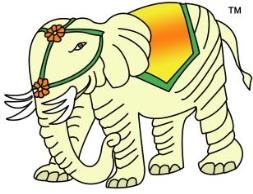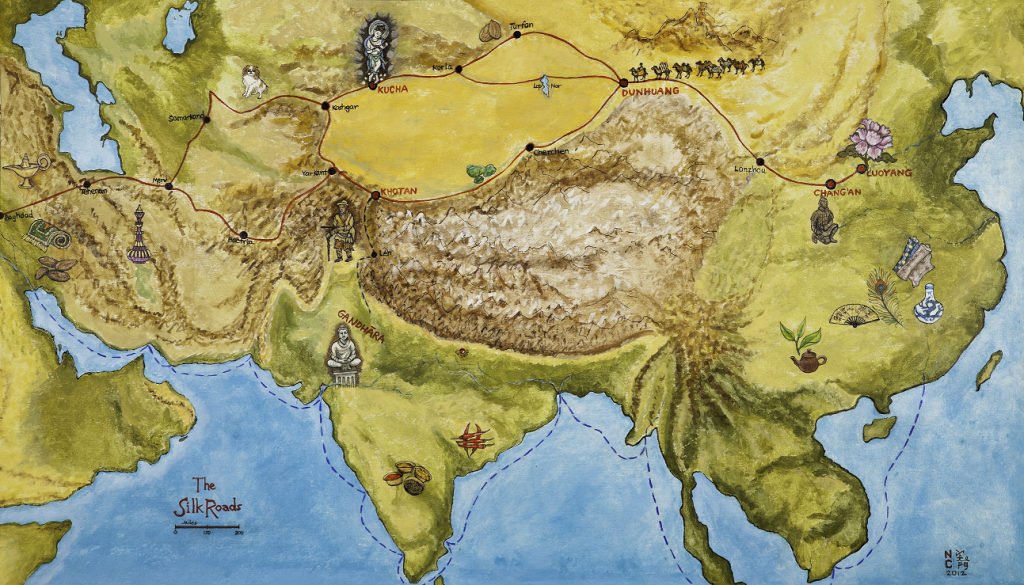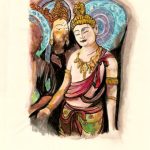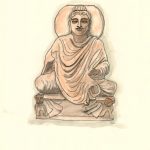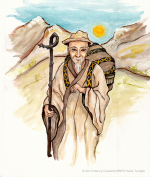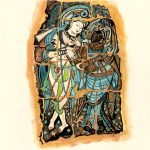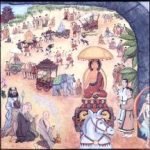Buddhism's Journey on the Silk Road
Besides cloth, paper and other goods, the Silk Road carried another important commodity which was equally significant in world history: Buddhism. Along with trade and migration, the world's oldest international highway was the vehicle which spread the religion throughout Central Asia. Transmission was launched from northwestern India, spreading to Pakistan, Afghanistan, Central Asia, Xinjiang (Chinese Turkistan), China, Korea, and Japan. Buddhism not only affected the lives and cultures of those regions, but also left us with a world of wonders in arts and literature.
5 KEY LOCATIONS OF THE SILK ROAD
Dunhuang
The Silk Road forked at Dunhuang, an oasis situated amid the Gobi and Taklimakan Deserts, forcing merchant caravans to choose between the northern and southern routes. Over time, these and other pilgrims began constructing cave shrines to insure divine protection or in thanks for completing the desert journey. This tradition inspired Buddhist monks to begin work in the nearby Mogao Caves, circa 366 C.E. The exquisite murals and statuary that developed are still preserved in these Buddhist grottoes, along with a walled-up library that housed a comprehensive collection of ancient manuscripts.
Ghandara
Once the center of the Kuṣāṇa empire (60 – 226 CE) which spread across northwestern India and Pakistan, the Buddhist settlement of Gandhāra was known for producing early manuscripts in Gandhāri, a language derived from Sanskrit. These works included the first full-length biography of Śākyamuni Buddha (the Buddhacarita). Thanks to European forays into India from the time of Alexander the Great, artisans in the ancient kingdom developed a blend of classic Greco-Roman and local styles. The resulting art movement furthered the transmission of Buddhism along the Silk Routes.
Khotan
An oasis town lying in the Tarim Basin, Khotan is strategically located at the junction of the southern Silk Road and one of the main routes to ancient India. As such, it was a convenient meeting place where not only trade goods, but philosophy and religion were exchanged. Circa 399 C.E., a Chinese pilgrim, Faxian traversed the entire region on foot in order to collect and translate Buddhist vinayas and sūtras. After returning to China in 414 C.E., he wrote vivid accounts of his journey, including the image processions in celebration of the Buddha's birthday which he witnessed in Khotan.
Kucha
As a Central Asian metropolitan center on the northern Silk Road, Kucha played a major role in trade economy. By the end of the third century, the kingdom had fully embraced Buddhism, establishing nearly 1,000 temples and stūpas in the immediate vicinity. At this time, Kuchean monks such as Fotucheng (232 – 348) began travel to the east, furthering the dissemination of the religion. Exotic Kuchean music and dance forms that blended Indian, middle, and far eastern flavors were introduced to China via the Silk Road and memorialized in the cave art at nearby Kizil.
Luoyang
Situated east of Xi'an on the Yellow River, the Northern Wei capital of Luoyang is considered a cradle of Chinese civilization and the peony capital of the world. It was also the eastern beginning of the ancient Silk Road. Acceptance of Buddhism by reigning emperors circa 500 C.E. led to the establishment of more than one thousand temples and monasteries in the region, all of which joined in creating image processions commemorating the Buddha's Birthday. These joyous annual celebrations are the subject of our triptych painting.
Download files:
- Silk Road Scroll High resolution image file
 02 Artworks: Silk Road Scroll 87.46 MB
02 Artworks: Silk Road Scroll 87.46 MB
2. Hotspot html file
